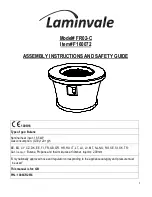
8
W415-0120 / F / 10.25.11
ing a vacation or a warm weather season, the fi replace
may emit a slight odour for a few hours. This is caused
by dust particles in the heat exchanger burning off. Open
a window to suffi ciently ventilate the room.
FIGURE 10
OPERATION / MAINTENANCE
SPILL SWITCH
VENTING ACTION CHECK
Remove the backing of the logo supplied and place on the
glass viewing area, as indicated.
LOGO
1
1
/
8
"
1
3
/
8
"
LOGO PLACEMENT
FIGURE 9
This is a thermally activated switch, attached to the back of
the unit and extending up into the dilution draft hood, which
senses the change in temperature and shuts down the gas
valve in the event of a severe downdraft of air or a blocked
or disconnected vent.
It acts as a safety shut-off to prevent a build up of carbon
monoxide or an explosion of unburnt gases during start up. If
the fl ue is blocked or has no "draw", the spill switch will auto-
matically shut off the supply of gas within about 5-10 minutes.
TAMPERING WITH THE SWITCH CAN RESULT IN CAR-
BON MONOXIDE (CO) POISONING AND POSSIBLE
DEATH.
A CHECK FOR CORRECT VENTING ACTION MUST BE
MADE BEFORE THE INSTALLED INSERT IS LEFT WITH
THE CUSTOMER.
Test after installing the unit into a vented non-combustible
fi replace in the following manner:
1.
Close all doors and windows in the room; start exhaust
fans in the home; turn fi replace blower off.
2.
Set controls to "high" and light the unit.
3.
Wait 5 minutes. Light a match and hold it to the spill tube
opening.
4.
Venting action is satisfactory if smoke is drawn into the spill
tube. Venting action is unsatisfactory if the fl ame and smoke
are not drawn into the tube.
5.
If venting action is unsatisfactory, turn the unit off, wait
10 minutes and try again. If the smoke or fl ame is still not
drawn into the spill tube, turn the unit off and check for vent
blockage or restriction. If necessary, consult with a qualifi ed
air quality specialist.
When lit for the fi rst time, the fi replace will emit a slight
odour for a few hours. This is a normal temporary condi-
tion caused by the curing of the logs and the "burn-in" of
internal paints and lubricants used in the manufacturing
process and will not occur again. Simply open a window
to suffi ciently ventilate the room.
After extended periods of non-operation such as follow-


































